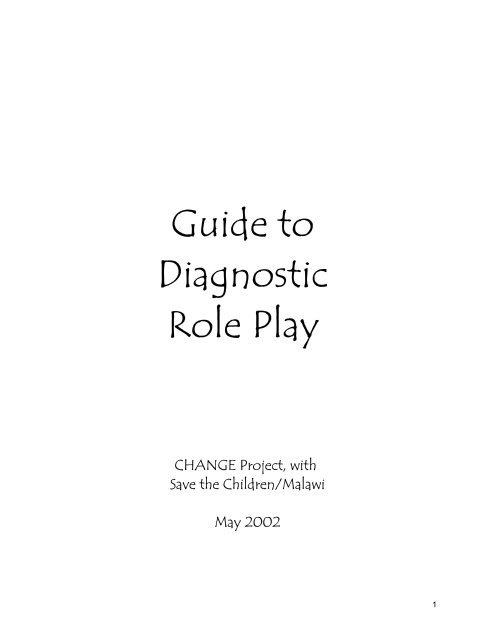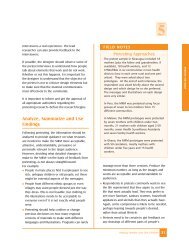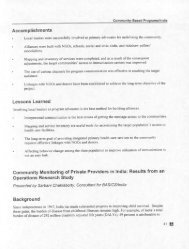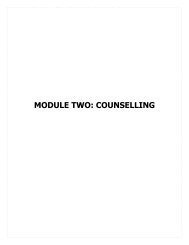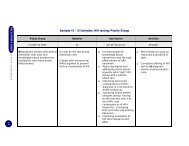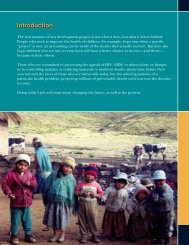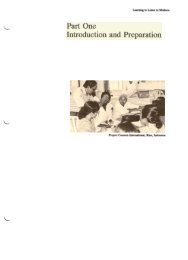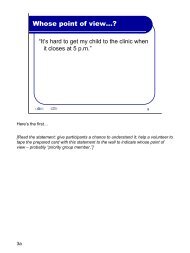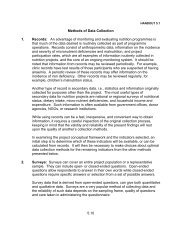Guide to Diagnostic Role Play
Guide to Diagnostic Role Play
Guide to Diagnostic Role Play
You also want an ePaper? Increase the reach of your titles
YUMPU automatically turns print PDFs into web optimized ePapers that Google loves.
<strong>Guide</strong> <strong>to</strong><br />
<strong>Diagnostic</strong><br />
<strong>Role</strong> <strong>Play</strong><br />
CHANGE Project, with<br />
Save the Children/Malawi<br />
May 2002<br />
1
Table of Contents<br />
<strong>Diagnostic</strong> <strong>Role</strong> <strong>Play</strong>: Overview .................................................................................. 3<br />
What is diagnostic role play? ............................................................................................. 3<br />
Why use DRP in formative research? ................................................................................. 4<br />
How <strong>to</strong> organize diagnostic role plays ................................................................................ 5<br />
How <strong>to</strong> stage a diagnostic role play ................................................................................... 6<br />
Staff roles & responsibilities ........................................................................................ 7<br />
Appendix 1: Malawi <strong>Guide</strong> <strong>to</strong> the <strong>Diagnostic</strong> <strong>Role</strong> <strong>Play</strong> ............................................... 9<br />
Questions for the 1 st role play: ........................................................................................ 12<br />
Questions for the 2 nd (Problem-Solving <strong>Role</strong> <strong>Play</strong>): .......................................................... 12<br />
CHILDREN ..................................................................................................................... 14<br />
Scenario 1: Resisting peer pressure (delay, s<strong>to</strong>pping, in relationship)............................ 14<br />
Scenario 2: How <strong>to</strong> negotiate condom use................................................................... 14<br />
Scenario 3: How <strong>to</strong> avoid transactional sex.................................................................. 14<br />
PARENTS ....................................................................................................................... 15<br />
Scenario 1: How parents can talk with their children about HIV/AIDS............................ 15<br />
Scenario 2: How parents can clarify their own values and expectations for their children 15<br />
Scenario 3: When someone teaches condoms <strong>to</strong> young children................................... 15<br />
Scenario 4: How girls can avoid transactional sex ........................................................ 15<br />
Scenario 5: How girls can avoid risky situations ............................................................ 15<br />
Appendix 2: <strong>Guide</strong>s for Note-Takers.......................................................................... 16<br />
2
<strong>Diagnostic</strong> <strong>Role</strong> <strong>Play</strong>: Overview<br />
This manual was prepared <strong>to</strong> guide a pilot test, in April 2002 in Mangochi District, Malawi, of a research<br />
method called <strong>Diagnostic</strong> <strong>Role</strong> <strong>Play</strong> (DRP). Carried out by the CHANGE Project with Save the<br />
Children/Malawi’s School Health and Nutrition Program, the pilot test focused on various preventive<br />
behaviors related <strong>to</strong> HIV/AIDS. After this experience, the manual was somewhat revised <strong>to</strong> reflect<br />
lessons learned (summarized in the box below). The manual is now offered for the use of program<br />
planners and researchers in general. It is hoped that they will find it helpful and that they will give the<br />
CHANGE Project feedback so that the method can continue <strong>to</strong> be improved.<br />
What is diagnostic role play?<br />
<strong>Diagnostic</strong> <strong>Role</strong> <strong>Play</strong> (DRP) is a new qualitative research method <strong>to</strong> help programs learn more<br />
about important current behaviors and develop effective strategies that promote and support<br />
alternative behaviors that should result in improved health. As opposed <strong>to</strong> other uses of drama<br />
in health programs, DRP can be used <strong>to</strong> learn about behaviors, not as a program intervention <strong>to</strong><br />
have participants model or try out new behaviors. As its name implies, the DRP combines the<br />
process of diagnosis, or examination and analysis, with role play; it is a simulation in which<br />
participants act out the typical attitudes and behaviors of individuals in a given context. This<br />
means that researchers and program managers can use DRP <strong>to</strong> help them:<br />
• examine behaviors, spoken words, and interactions,<br />
• understand why people behave as they do and<br />
• identify feasible ways <strong>to</strong> help them move <strong>to</strong>wards behaviors that are desirable <strong>to</strong> their<br />
health.<br />
General Conclusions and Recommendations Based on the Malawi Experience<br />
When <strong>to</strong> use DRP:<br />
• It is best <strong>to</strong> use DRP relatively early in the formative research process—after in-depth<br />
interviews reveal enough about the issues <strong>to</strong> plan interesting drama scenarios. It is possible<br />
that, if used at this point in the learning process, DRP may reduce the number of additional<br />
in-depth interviews or focus group discussions needed.<br />
• It is used late in the process (as was done in Malawi), DRP may yield interesting expressions,<br />
and possibly ideas for solutions <strong>to</strong> participant-identified problems that can inform subsequent<br />
research steps.<br />
• DRP is probably best for learning about rare situations that cannot be easily observed, such<br />
as what happens when there is an obstetrical emergency or when a child suddenly develops<br />
paralysis. It may also be useful for sensitive situations that are not easily discussed, such as<br />
what happens when a girl and boy start <strong>to</strong> date.<br />
• <strong>Play</strong>ers in the DRP came up with innovative solutions when given clear instructions and<br />
direction. In contrast, participants of in-depth interviews and group discussions did not<br />
discuss realistic solutions. Acting out an idea seemed <strong>to</strong> help participants think concretely<br />
about the steps.<br />
3
How <strong>to</strong> maximize useful results:<br />
• The facilita<strong>to</strong>r is key <strong>to</strong> the method’s effectiveness. S/he must have a good understanding of<br />
both the method and the technical and social issues. S/he must speak the local dialect fluently.<br />
• It is helpful when the facilita<strong>to</strong>r makes the atmosphere informal <strong>to</strong> encourage free dialogue by<br />
starting with ice-breakers or games and foregoing formal introductions.<br />
• The facilita<strong>to</strong>r needs <strong>to</strong> emphasize that there is no “right” or “wrong” answer <strong>to</strong> the scenes. It<br />
was difficult <strong>to</strong> get past ideals that participants held. Often people would act and answer<br />
according <strong>to</strong> ideals rather than their own reality. (For example, boys talked about boys who go<br />
<strong>to</strong> school as boys who do not have a girlfriend or have sex. Those same boys, however, manage<br />
<strong>to</strong> do both!)<br />
• The players should start by introducing their characters, and one of them may serve as a<br />
narra<strong>to</strong>r who lays out the scenes.<br />
• <strong>Play</strong>ers need <strong>to</strong> be encouraged <strong>to</strong> add local color and actions that shows normal behavior and<br />
conversations in the settings portrayed. Too many of the first role plays were just animated<br />
conversations about the given <strong>to</strong>pic. The facilita<strong>to</strong>r or note-taker should work with players as<br />
they plan their role-plays and actions (especially when children are the players).<br />
• In the first few role-plays, participants seemed <strong>to</strong> be somewhat intimidated by the presence of<br />
members of the opposite sex and by videotaping. Additional efforts were made in later role-plays<br />
<strong>to</strong> keep groups single-sex.<br />
• Regarding length of time, it worked well <strong>to</strong> have each drama have at least two scenes that last a<br />
<strong>to</strong>tal of 10 <strong>to</strong> 15 minutes. This was enough time for players <strong>to</strong> act out the main idea of the scene<br />
as well as fill in all of the actions before and after, and not <strong>to</strong>o long that the audience got tired or<br />
restless.<br />
Other issues <strong>to</strong> consider:<br />
• Suggest that audience members question each player in character. At the end of the drama,<br />
invite the audience <strong>to</strong> ask players questions on a “hot seat” about how they felt and what they<br />
thought when they did or said certain things during the role-play, which they should answer in<br />
character.<br />
• Introduce a concluding activity. Because poetry is a popular art form in Mangochi, the facilita<strong>to</strong>r<br />
asked one or more volunteers <strong>to</strong> prepare poems that summarized the drama and discussions<br />
after the discussions finished. About five minutes was needed for participants <strong>to</strong> prepare poems.<br />
This worked very well in Malawi <strong>to</strong> conclude the sessions (in many cases, several participants<br />
contributed poems), but is not appropriate everywhere. A song may be better in other settings<br />
(or this finale may be omitted).<br />
• Watch for visual data. A comparative advantage of the DRP is that people act out normal<br />
situations that can visually depict relationships between characters. Although the role-plays in<br />
the field test did not elicit much visual data on relationships, because players spoke more than<br />
carried out actions, other situations could gather good visual data.<br />
In conclusion, DRP seems <strong>to</strong> have promise as a qualitative research method that may yield certain<br />
information (what happens in rare situations, popular expressions and metaphors, social relationships,<br />
and participant-generated solutions <strong>to</strong> problems) not easily obtainable by other research methods. Used<br />
early in the formative research process, it may reduce the number of additional interviews and/or group<br />
discussions needed.<br />
Why use DRP in formative research?<br />
Unlike other research methods, DRP gives information and understanding through actions and<br />
“normal” conversation by requiring participants <strong>to</strong> do or act rather than just talk about a <strong>to</strong>pic.<br />
4
DRP asks participants <strong>to</strong> show, <strong>to</strong> demonstrate, or <strong>to</strong> portray normal things in their lives.<br />
People act out certain situations that show “normal” behavior, not necessarily their own<br />
personal behavior.<br />
The role play is a stimulus for discussion afterwards among the players and the audience.<br />
There can then be a second role play and discussion about the same issues, one that either<br />
gives an alternative, more realistic picture of normal life, or one that presents reasonable and<br />
feasible solutions <strong>to</strong> the problem situation. In Malawi, each set of role plays was followed by a<br />
volunteer or volunteers composing and reciting a poem that captured the key points that came<br />
out, but this finale is certainly not appropriate everywhere.<br />
This type of research helps clarify or get more in-depth understanding about insights and<br />
concepts that emerge from the review of existing information and initial in-depth interviews—<br />
normally the first research methods used.<br />
DRP has a number of potential advantages. It lets researchers see real-life situations that they<br />
may not otherwise be able <strong>to</strong> see because they are private or very rare; for example, what<br />
happens in the home when a pregnant woman or child has a medical emergency (who gets<br />
involved, what do various people say, whose opinion decides?). It also illustrates behaviors,<br />
including social interactions, and ways people communicate that seem so normal <strong>to</strong> people that<br />
they will not talk about them otherwise. And because some behaviors are sensitive, people<br />
may be more willing <strong>to</strong> act them out and discuss them when they are not portraying<br />
themselves. Finally, options or solutions available <strong>to</strong> people can be discussed in a group using<br />
concrete examples.<br />
In return, DRP gives participants an opportunity <strong>to</strong> discuss the issues and <strong>to</strong> have input in<strong>to</strong><br />
research findings and their program implications. It also should be fun for participants.<br />
Although the role plays can be very entertaining, they are intended <strong>to</strong> learn more from the<br />
participant groups in order <strong>to</strong> design an effective program intervention (in this case, <strong>to</strong> prevent<br />
HIV/AIDS among school-age children).<br />
How <strong>to</strong> organize diagnostic role plays<br />
Three groups are essential in a DRP:<br />
• Participants: players<br />
• Participants: audience members<br />
• Research team<br />
Participants: There should be 10 <strong>to</strong> 15 participants in each group. Three <strong>to</strong> five of the<br />
participants can be players “on stage.” The other 10 <strong>to</strong> 12 participants have an important role<br />
as well. Audience members must watch closely and, with the players also, discuss the<br />
performance. It is through that discussion that many of the issues and findings will come out.<br />
DRP will work best if the number of participants is limited so that people get an opportunity <strong>to</strong><br />
discuss in-depth the performance and the issues.<br />
5
Research Team: The research team consists of a facilita<strong>to</strong>r and two note-takers. The facilita<strong>to</strong>r<br />
is in charge of orienting participants and leading the discussion after the performance.<br />
How <strong>to</strong> stage a diagnostic role play<br />
1. Clearly agree & answer the following questions:<br />
• What are the research objectives?<br />
• What issues were raised during the in-depth interviews?<br />
• What are the important socio-cultural roles, relationships, and norms related <strong>to</strong><br />
HIV/AIDS?<br />
• What themes would be good <strong>to</strong> try?<br />
2. Select themes.<br />
Consider several scenarios concerning concepts or behaviors that earlier research<br />
indicates are important but which are not yet completely clear <strong>to</strong> the<br />
researchers.<br />
3. Decide what participant groups will be needed.<br />
Criteria for selection are simply representative people from the participant<br />
groups.<br />
In this case, both student groups and parent groups were invited <strong>to</strong> conduct role<br />
plays, separately, for different <strong>to</strong>pics. Leaders and initiation counselors can be<br />
included in the parent groups.<br />
Experienced ac<strong>to</strong>rs do not need <strong>to</strong> be found. It is best <strong>to</strong> have community<br />
members who are truly ‘normal’ and typical.<br />
4. Plan the logistics of the DRPs.<br />
Each group will need one and a half <strong>to</strong> two hours <strong>to</strong> perform and discuss at least<br />
two basic scenarios on a theme of interest. If four groups can be arranged for<br />
each day, a maximum of 2 <strong>to</strong> 4 themes per day can be selected. Make<br />
arrangements for a location that can be private and where participants will feel<br />
comfortable. Make arrangements with local persons <strong>to</strong> recruit participants who<br />
meet your criteria.<br />
5. Create scenes for participants <strong>to</strong> act out.<br />
Develop your themes in<strong>to</strong> fuller scenarios with one or more locations, certain<br />
types of characters, certain situations or occurrences.<br />
6


